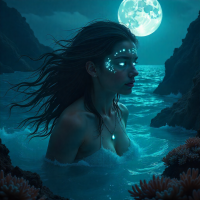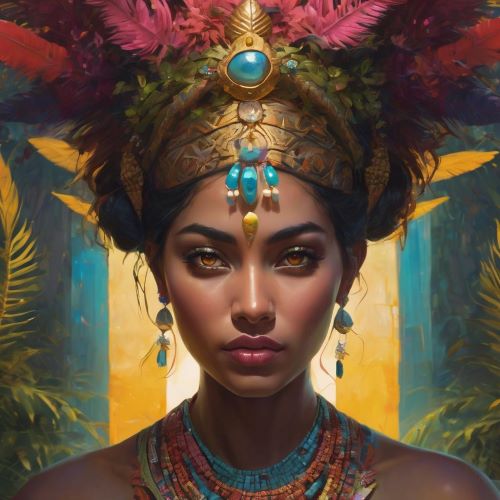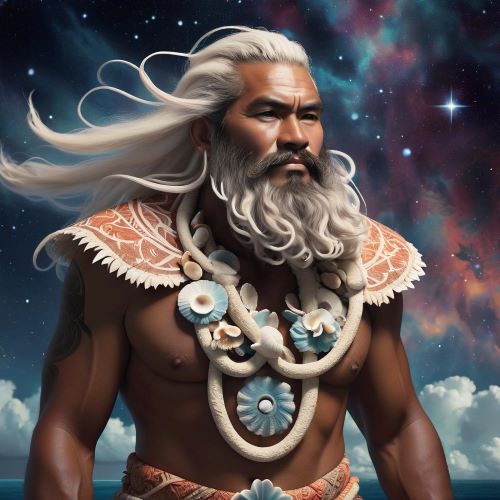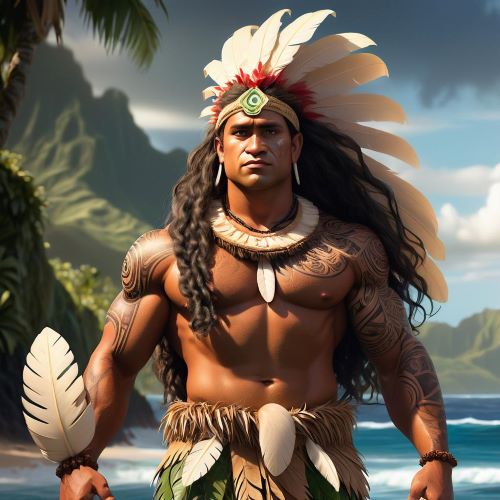Aiaru : The Oceanic Guardian of Death and Fate in Tahitian Mythology
Listen
At a glance
| Description | |
|---|---|
| Origin | Tahitian Mythology |
| Classification | Gods |
| Family Members | Fa’ahotu (Mother), Raiatea (Father), Tama’eva, Moana-uri (Siblings) |
| Region | Tahiti |
| Associated With | Ocean, Death, Fate |
Aiaru
Introduction
In the vast expanse of Tahitian mythology, Aiaru stands as a mysterious and compelling figure—a goddess who governs the delicate boundary between life and death. Revered as one of the Seven Guardians of the World, Aiaru holds dominion over fate and transition, embodying both the inevitability of mortality and the continuity of existence. Unlike the widely celebrated gods such as Ta’aroa, the creator, or Oro, the god of war and fertility, Aiaru’s presence dwells in quieter depths, in the unseen currents of the ocean and the stillness between breaths. She is a deity of reflection and passage, reminding her followers of life’s impermanence and the sacredness of the natural cycle. Understanding Aiaru opens a window into the Polynesian worldview where spirituality, nature, and destiny intertwine seamlessly.
Physical Traits
Descriptions of Aiaru’s appearance differ among Polynesian islands, reflecting the fluidity of oral traditions. She is often envisioned as an ethereal figure born from the sea’s depths—her long, flowing hair resembling drifting seaweed, and her eyes gleaming like the bioluminescent shimmer of deep-water fish. Some myths describe her as a hybrid being, part human and part aquatic, symbolizing the union of the physical and spiritual realms. Others portray her as translucent, her form shifting with the ocean’s tides, a visual metaphor for her elusive and ever-changing nature.
This connection to the sea mirrors the Polynesian belief that divinity resides within natural forces. Aiaru’s embodiment of water—fluid, mysterious, and life-sustaining—illustrates her dual role as both nurturer and guide to the afterlife. Her beauty is not human perfection but elemental power, reflecting how Polynesian deities often manifest as extensions of their environment rather than separate entities.
Family
Aiaru’s lineage, much like her nature, is shrouded in mystery. Tahitian oral traditions rarely define her parentage, emphasizing instead her role within the divine council of the Seven Guardians of the World. Alongside deities such as Fa’a’ipu, Firifiri’Aufau, and Tahu’a, Aiaru is believed to maintain the cosmic equilibrium that sustains existence. Each guardian oversees a vital domain of life and nature—Aiaru’s domain being death, destiny, and spiritual transition.
In certain regional versions of Polynesian lore, Aiaru is described as the daughter of a primordial sea goddess and a celestial spirit, linking her to both oceanic and astral energies. This dual heritage represents the balance between the material and spiritual worlds, reinforcing her role as a mediator who guides souls across boundaries. Her connection to divine siblings associated with tides, stars, and storms symbolizes the interconnectedness of Polynesian cosmology, where all life forms part of a larger spiritual web.
Other names
Within Tahitian mythology, Aiaru is primarily recognized by this name, yet variations may exist across other Polynesian islands due to linguistic and cultural differences. Oral traditions often evolve as they travel between island groups, resulting in localized forms of divine identities. While no confirmed alternate names for Aiaru appear in existing records, scholars suggest that similar deities associated with oceanic transition and fate in neighboring traditions may share conceptual roots with her.
The preservation of the name Aiaru in Tahitian narratives indicates her singular importance within this cultural framework. Unlike deities who appear under numerous appellations, Aiaru’s identity remains consistent—a goddess defined by depth, silence, and the inevitability of transformation.
Powers and Abilities
Aiaru’s powers stem from her dominion over death, fate, and the emotional tides that bind human experience to the natural world. She is said to possess prophetic insight, able to foresee the circumstances of mortal death and guide souls from the physical plane to the spiritual. This role grants her both reverence and awe among devotees, who viewed her not as a harbinger of fear but as a compassionate guardian ensuring safe passage into the afterlife.
Her powers are also linked to the ocean’s rhythms. Fishermen and navigators would invoke Aiaru for calm seas and safe voyages, believing she controlled the balance between tempest and tranquility. Shamans and priests often sought her wisdom through dreams and trance rituals, interpreting her messages as guidance for community well-being. Beyond her association with mortality, Aiaru symbolizes emotional healing, reflection, and acceptance—qualities that reveal her gentle yet profound spiritual authority.
In certain interpretations, Aiaru’s wrath manifests through environmental imbalance. When humanity disrupts the harmony of the ocean through greed or disrespect, she responds with storms or silence—signs of divine withdrawal. Thus, she embodies ecological justice, a spiritual protector of both marine life and moral order.
Modern Day Influence
Although Aiaru’s worship has largely faded following colonial disruption and the spread of Christianity, her presence endures in the cultural memory of Tahiti. Modern Tahitian artists, poets, and conservationists invoke Aiaru as a symbol of environmental guardianship and ancestral wisdom. Her image frequently appears in tattoos, carvings, and ocean-inspired artworks that celebrate Polynesia’s deep connection to the sea.
In contemporary Tahitian spiritual movements, Aiaru represents emotional resilience and ecological balance. Activists working to protect coral reefs and marine ecosystems often refer to her myth as a reminder of humanity’s duty to respect the ocean. Aiaru’s resurgence in literature and performance art mirrors a broader Polynesian renaissance that seeks to reclaim indigenous cosmologies as sources of strength and identity.
Through her association with destiny and the ocean, Aiaru continues to inspire both reverence and reflection. She is not merely a goddess of death but a teacher of balance—reminding humanity that life, death, and nature flow together in one endless current.
Related Images
Source
Allen, R., & Saunders, C. (2019). Aiaru – the Tahitian Goddess of Death. Godchecker. Retrieved November 9, 2025, from https://www.godchecker.com/polynesian-mythology/aiaru/
Smith, J. (2023). Polynesian Myth and Spirit Guardians. Oceanic Publishing.
Brown, T. (2024). Guardians of the Polynesian World: A Cultural Study. University Press.
Encyclopedia of Polynesian Mythology. (2025). Aiaru. Pacific Cultural Institute.
Williams, K. (2023). Death Deities Across Cultures: A Comparative Analysis. Mythological Review, 12(3), 45-61.
Mythological Figures and Modern Influence. (2024). Polynesian Spirituality Journal, 8(2), 77-93.
Kirch, P. V. (2017). On the Road of the Winds: An Archaeological History of the Pacific Islands. University of California Press.
Salmond, A. (2010). Aphrodite’s Island: The European Discovery of Tahiti. University of California Press.
Dening, G. (1980). Islands and Beaches: Discourse on a Silent Land. University of Hawaii Press.
Frequently Asked Questions
Who is Aiaru in Tahitian mythology?
Aiaru is a goddess of death and fate in Tahitian mythology, known as one of the Seven Guardians of the World who maintain cosmic balance.
What is Aiaru known for?
She governs the transition between life and death and possesses prophetic powers to foresee human destiny, guiding souls to the afterlife.
How is Aiaru depicted in mythology?
Aiaru is often portrayed as a sea spirit with flowing seaweed-like hair and glowing eyes, symbolizing the connection between the ocean and the spiritual realm.
What powers does Aiaru possess?
Aiaru controls fate, death, and emotional harmony, as well as influencing oceanic conditions like tides and storms as reflections of human balance.
Is Aiaru still worshipped today?
While direct worship has declined, Aiaru remains a symbol of environmental protection and cultural revival in modern Tahitian art and spirituality.









